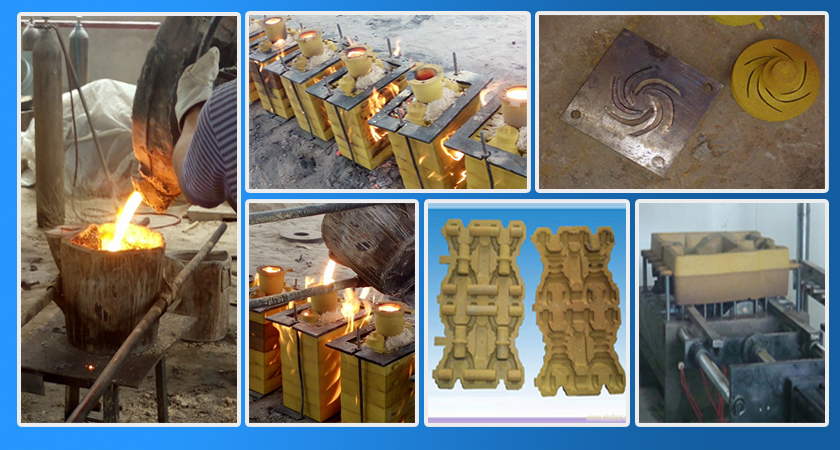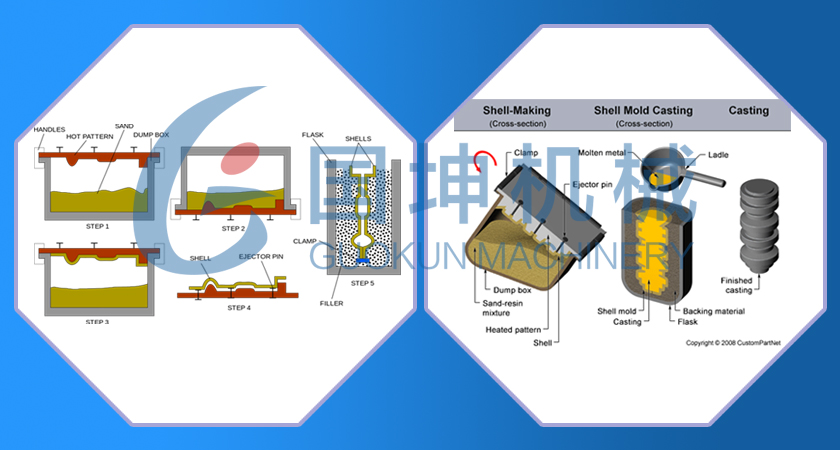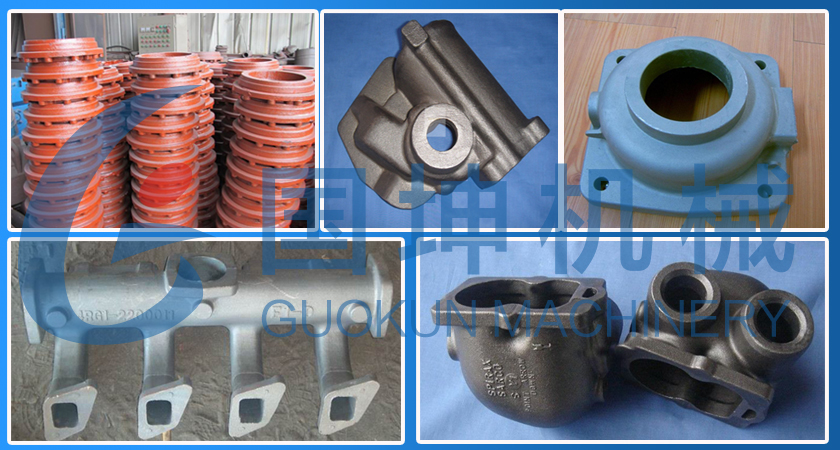Shell Mold Casting Process
Shell Mould Casting is an expendable mold casting process that uses a resin covered sand to form the mold. As compared to sand casting, this process has better dimensional accuracy, a higher productivity rate, and lower labor requirements. It is used for small to medium parts that require high precision. Shell mold casting is a metal casting process similar to sand casting, in that molten metal is poured into an expendable mold. However, in shell mold casting, the mold is a thin-walled shell created from applying a sand-resin mixture around a pattern. The pattern, a metal piece in the shape of the desired parts, is reused to form multiple shell molds. A reusable pattern allows for higher production rates, while the disposable molds enable complex geometries to be cast. Shell mold casting requires the use of a metal pattern, oven, sand-resin mixture, dump box, and molten metal.

Ferrous and non-ferrous Metals for shell mold casting
Shell mold casting allows the use of both ferrous and non-ferrous metals, most commonly using cast iron, carbon steel, alloy steel, stainless steel, aluminum alloys, and copper alloys.
- Gray iron shell mold casting, such as ASTM A48/A48M, ASTM A159, BS EN 1561, DIN 1691, etc
- Ductile iron shell mold casting, such as ASTM A536, BS EN 1563, GB/T 1348-1988, etc
- Carbon steel shell mold casting, such as ASTM A29/A29M(1030, 1040, 1045, 1050, etc)
- Alloy steel shell mold casting, such as SAE J1249 (4140, 4340, 8140, 8630, etc)
- Stainless steel shell mold casting, such as ASTM A959 (304, 316, 316L, etc)
- Aluminum alloy shell mold casting, such as ASTM B85-96(ASTM A356, A360, A383), JIS H5302:2000(ADC10.1, ADC12, etc), GB/T 15115-1994(YL102, YL112, etc)
- Bronze & copper alloys shell mold casting
The Shell Mold Casting process consists of the following steps:
- Pattern Creation: A two-piece metal pattern is created in the shape of the desired part, typically from iron or steel. Other materials are sometimes used, such as aluminum for low volume production or graphite for casting reactive materials.
- Mold creation: First, each pattern half is heated to 175-370℃(350-7000℉) and coated with a lubricant to facilitate removal. Next, the heated pattern is clamped to a dump box, which contains a mixture of sand and a resin binder. The dump box is inverted, allowing this sand-resin mixture to coat the pattern. The heated pattern partially cures the mixture, which now forms a shell around the pattern. Each pattern half and surrounding shell is cured to completion in an oven and then the shell is ejected from the pattern.
- Mold assembly: The two shell halves are joined together and securely clamped to form the complete shell mold. If any cores are required, they are inserted prior to closing the mold. The shell mold is then placed into a flask and supported by a backing material.
- Pouring: The mold is securely clamped together while the molten metal is poured from a ladle into the gating system and fills the mold cavity.
- Cooling: After the mold has been filled, the molten metal is allowed to cool and solidify into the shape of the final casting.
- Casting removal: After the molten metal has cooled, the mold can be broken and the casting removed. Trimming and cleaning processes are required to remove any excess metal from the feed system and any sand from the mold.

Shell Mold Casting’s advantage and disadvantage
- Advantages: Can form complex shapes and fine details; Very good surface finish; High production rate; Low labor cost(if automated); Low tooling cost; Little scrap generated; Can produce very large parts; Can form complex shapes; Many material Options; Low tooling and equipment cost; Scrap can be recycled; Short lead time possible
- Disadvantages: High equipment cost; Poor material strength; High porosity possible; Secondary machining often required; High labor cost(if done manually)
Application of Resin Sand Castings
Typical parts are small-to-medium in size and require high accuracy and good surface finish, such as gear housing, engine blocks and manifolds, machine bases, gears, pulleys, cylinder heads, connecting rods, and lever arms.
